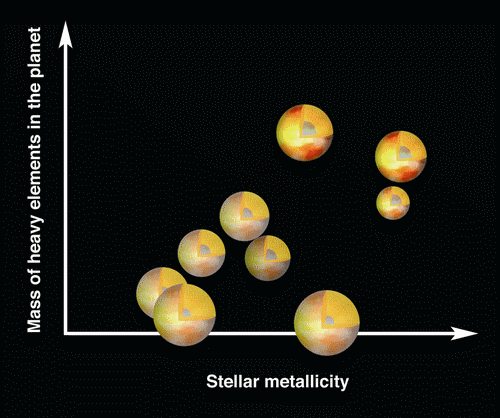A&A press release: Interiors of extrasolar planets: A first step (30 May 2006)
- Details
- Published on 30 May 2006
A&A press release
Released on May 30th, 2006
|
Interiors of extrasolar planets: A first step |
Based on the article “A correlation between the heavy element content of transiting extrasolar planets and the metallicity of their parent stars”, by Guillot et al.
(To be published in Astronomy & Astrophysics. )
This press release is issued as a collaboration with the CNRS and Astronomy & Astrophysics.
A team of European astronomers, led by T. Guillot (CNRS, Observatoire
de la Côte d’Azur, France), will publish a new study of the physics of
Pegasids (also known as hot Jupiters) in Astronomy & Astrophysics.
They found that the amount of heavy elements in Pegasids is correlated
to the metallicity of their parent stars. This is a first step in
understanding the physical nature of the extrasolar planets.
Up to now, astronomers have discovered 188 extrasolar planets,
among which 10 are known as “transiting planets”. These planets pass
between their star and us at each orbit (Figure 1). Given the current
technical limitations, the only transiting planets that can be detected
are giant planets orbiting close to their parent star known as “hot
Jupiters” or Pegasids. The ten transiting planets known thus far have
masses between 110 and 430 Earth masses (for comparison, Jupiter, with
318 Earth masses, is the most massive planet in our Solar System).

Fig. 1 - Animation of a typical Pegasid system, with both the star and planet drawn to scale. Here, the planet orbits the star in just 3.5 days. For comparison, the Earth orbits the Sun every single year, and Mercury, which has the shortest orbital period in the solar system, orbits the Sun every 88 days.
Although rare, transiting planets are the key to understanding
planetary formation because they are the only ones for which both the
mass and radius can be determined. In principle, the obtained mean
density can constrain their global composition. However, translating a
mean density into a global composition needs accurate models of the
internal structure and evolution of planets. The situation is made
difficult by our relatively poor knowledge of the behaviour of matter
at high pressures (the pressure in the interiors of giant planets is
more than a million times the atmospheric pressure on Earth). Of the
nine transiting planets known up to April 2006, only the least massive
one could have its global composition determined satisfactorily. It was
shown to possess a massive core of heavy elements, about 70 times the
mass of the Earth, with a 40 Earth-mass envelope of hydrogen and
helium. Of the remaining eight planets, six were found to be mostly
made up of hydrogen and helium, like Jupiter and Saturn, but their core
mass could not be determined. The last two were found to be too large
to be explained by simple models.
Considering them as an ensemble for the first time, and
accounting for the anomalously large planets, Tristan Guillot and his
team [1] found that the nine transiting planets have homogeneous
properties, with a core mass ranging from 0 (no core, or a small one)
up to 100 times the mass of the Earth, and a surrounding envelope of
hydrogen and helium. Some of the Pegasids should therefore contain
larger amounts of heavy elements than expected. When comparing the mass
of heavy elements in the Pegasids to the metallicity of the parent
stars, they also found a correlation to exist, with planets born around
stars that are as metal-rich as our Sun and that have small cores,
while planets orbiting stars that contain two to three times more
metals have much larger cores, as shown in Figure 2. Their results will
be published in Astronomy & Astrophysics.
Planet formation models have failed to predict the large amounts of
heavy elements found this way in many planets, so these results imply
that they need revising. The correlation between stellar and planetary
composition has to be confirmed by further discoveries of transiting
planets, but this work is a first step in studying the physical nature
of extrasolar planets and their formation. It would explain why
transiting planets are so hard to find, to start with. Because most
Pegasids have relatively large cores, they are smaller than expected
and more difficult to detect in transit in front of their stars. In any
case, this is very promising for the CNES space mission COROT
to be launched in October, which should discover and lead to
characterization of tens of transiting planets, including smaller
planets and planets orbiting too far from their star to be detected
from the ground.
What of the tenth transiting planet? XO-1b was announced very recently (see NASA press release)
and is also found to be an anomalously large planet orbiting a star of
solar metallicity. Models imply that it has a very small core, so that
this new discovery strengthens the proposed stellar-planetary
metallicity correlation.

Fig. 2 - Correlation between the amount of heavy elements in the transiting planets and the metallicity of their parent stars.
[1] The team includes T. Guillot (France), N.C. Santos (Portugal), F. Pont (Switzerland), N. Iro (USA), C. Melo (Germany), I. Ribas (Spain).
A correlation between the heavy element content of transiting extrasolar planets and the metallicity of their parent stars
by T. Guillot, N.C. Santos, F. Pont, N. Iro, C. Melo, I. Ribas.
To be published in Astronomy & Astrophysics (DOI number: 10.1051/0004-6361:20065476)
To be published in Astronomy & Astrophysics (DOI number: 10.1051/0004-6361:20065476)
Contact persons:
- Science:
Dr. Tristan Guillot
Observatoire de la Côte d'Azur
Email: tristan.guillot (at) obs-nice.fr
Phone: +33 4 92 00 30 47 - +33 4 92 00 31 31
- Press office:
Dr. Jennifer Martin
Journal Astronomy & Astrophysics
61, avenue de l'Observatoire
75014 Paris, France
Phone: +33 1 43 29 05 41 - Email: aanda.paris (at) obspm.fr


